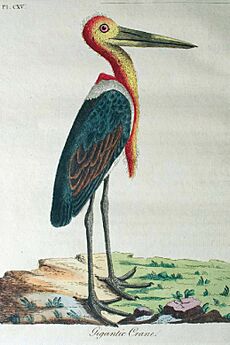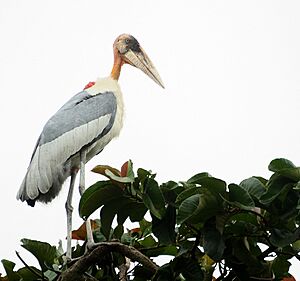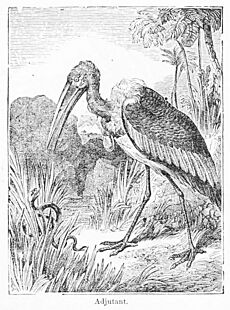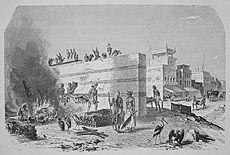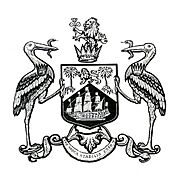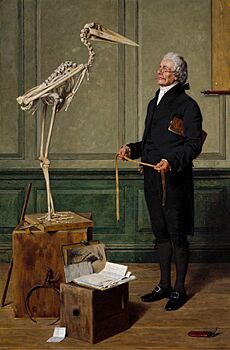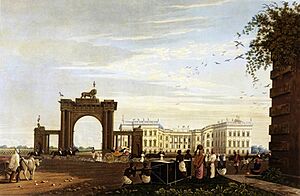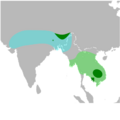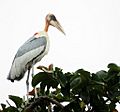Greater adjutant facts for kids
Quick facts for kids Greater adjutant |
|
|---|---|
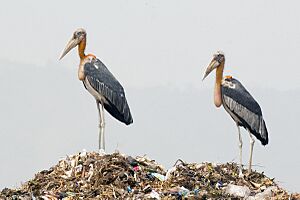 |
|
| Two adult Greater Adjutant storks, one with bright breeding colors, at a garbage dump in Assam. | |
| Conservation status | |
| Scientific classification | |
| Genus: |
Leptoptilos
|
| Species: |
dubius
|
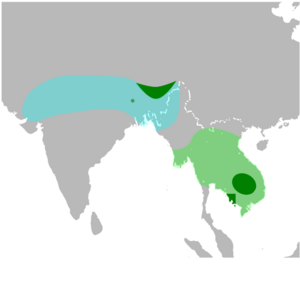 |
|
|
Breeding range Resident non-breeding range Seasonal non-breeding range
|
|
| Synonyms | |
|
Leptoptilus argala |
|
The greater adjutant (Leptoptilos dubius) is a very large bird that belongs to the stork family, called Ciconiidae. It is related to the lesser adjutant from Asia and the marabou stork from Africa.
These storks used to live across much of southern Asia and mainland southeast Asia. Now, they are found in much smaller areas. There are only three main places where they breed: two in India (one large group in Assam and a smaller one near Bhagalpur), and another group in Cambodia. After their breeding season, they fly to many different places.
The greater adjutant is easy to spot because of its huge, wedge-shaped beak, its bare head, and a special pouch on its neck. During the day, it flies high in the sky using warm air currents, just like vultures. This is because they both eat carrion (dead animals) and other waste. They are also good at catching live animals like vertebrates. The name "adjutant" comes from how they walk, which looks like a stiff, military march.
Long ago, many of these storks lived in Asia. However, their numbers have dropped a lot, possibly because of better sanitation (less garbage for them to eat). They are now an endangered species. In 2008, there were only about a thousand of them left. In the 1800s, they were very common in Calcutta (now Kolkata), India. People even called them the "Calcutta adjutant." They were seen as helpful because they cleaned up waste.
Contents
About the Greater Adjutant Stork
The greater adjutant is part of the stork family. It belongs to the genus Leptoptilos, which also includes the lesser adjutant and the marabou stork. These three storks are unique because they fly with their necks pulled back, like herons. Most other storks fly with their necks stretched out. This might be because their beaks are very heavy. When they walk on the ground, they have a stiff, marching style. This is where their name "adjutant" comes from.
What Does It Look Like?
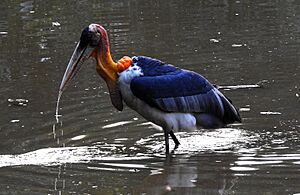
The greater adjutant is a giant bird. It can stand about 145 to 150 centimeters (4.7 to 4.9 feet) tall. Its wingspan can reach about 250 centimeters (8.2 feet). This makes it one of the largest living storks.
Its huge beak is about 32 centimeters (12.6 inches) long. It looks like a wedge and is pale grey with a darker bottom part. The bird has a bare head and neck, which are yellow to red. Around its neck, it has a white feathery collar. This makes it look a bit like a vulture.
During the breeding season, the pouch on its neck and its neck itself turn a bright orange. The upper parts of its grey legs also become reddish. Adult birds have dark wings that stand out against their lighter grey secondary feathers. Their belly is whitish. It's hard to tell males and females apart just by looking at them. Young birds look like duller versions of the adults.
The pouch hanging from its neck is inflatable. It connects to the bird's air passages, not its stomach. People once thought it was for storing food, but it's actually filled with air. Its exact purpose is still a bit of a mystery.
The only other bird that looks similar in its area is the smaller lesser adjutant. However, the lesser adjutant does not have a neck pouch. It also prefers wetlands and has a lighter grey head.
Like other storks, the greater adjutant cannot sing. It makes sounds by clattering its beak. It can also make low grunting or roaring sounds, especially when it is nesting. When it clatters its beak, it points its beak upwards.
Where Do They Live?
This stork used to visit many river plains in northern India during the winter. For a long time, no one knew where they bred. Then, in 1877, a very large nesting group was found in Burma (now Myanmar). This group, which also included spot-billed pelicans, got smaller and disappeared by the 1930s.
Later, a nest site in Kaziranga National Park in India was the only known breeding area. But new sites have since been found in Assam, around the Tonle Sap lake in Cambodia, and in the Kulen Promtep Wildlife Sanctuary. In 1989, there were about 115 breeding birds in Assam. By the mid-1990s, the population in the Brahmaputra Valley was around 600. A smaller group with about 35 nests was found near Bhagalpur in 2006, growing to 75 nests by 2014.
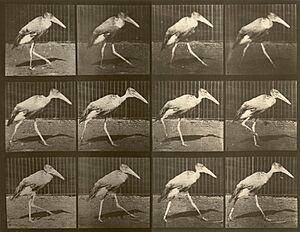
When they are not breeding, storks in India spread out across the Indo-Gangetic Plain. They are rarely seen in the southern Deccan Plateau. In the 1800s, many adjutant storks lived in the city of Calcutta during the summer and rainy seasons. They gathered near the riverbanks. However, these groups disappeared by the early 1900s. Better sanitation (less waste) is thought to be a reason for their decline.
How Do They Behave?
Greater adjutants are usually seen alone or in small groups. They walk around in shallow lakes, drying lake beds, and garbage dumps. You might often see them with kites and vultures. They sometimes sit still and hunched for a long time. They might also spread their wings out, probably to control their body temperature. They use warm air currents to soar high in the sky.
Reproduction and Life Cycle
Greater adjutants breed during the winter. They form colonies, sometimes with other large waterbirds like the spot-billed pelican. Their nests are big platforms made of twigs. They build them at the end of horizontal branches on tall trees. They rarely build nests in the middle of a tree, which makes it easier for them to fly to and from the nest. In Assam, they often choose Alstonia scholaris and Anthocephalus cadamba trees for nesting.
The breeding season starts when many birds gather and try to claim a tree. Males mark their nesting areas, chasing away other birds. They often point their beak upwards and clatter it. They might also arch their body and hold their wings half-open. When a female comes close, the male brings fresh twigs and places them in front of her. The male might also gently hold the female's leg with his beak or bring his beak close to hers.
A pair that has formed a bond will hold their beaks and heads close to each other. The female might rest her head on the male's chest, and the male might hold his beak over her neck. They also raise and lower their beaks together.
The female usually lays three or four white eggs, one or two days apart. Both parents take turns sitting on the eggs. The eggs hatch after about 35 days, also one or two days apart. Adult storks at the nest often have their legs covered in their droppings. This behavior, called urohidrosis, helps them stay cool in hot weather. Adults may also spread their wings to shade their chicks.
The chicks stay in the nest for about five months. They grow very quickly, doubling in size in just a week. When they are a month old, they can stand and walk around the nest platform. At five weeks, the young birds jump a lot and can defend themselves. At this stage, the parents leave them alone at the nest for longer periods. The young birds leave the nest and fly around the colony when they are about four months old, but their parents still feed them sometimes.
What Do They Eat?
The greater adjutant is an omnivore, meaning it eats both plants and animals. While it mainly eats dead animals, it also hunts frogs, large insects, birds, reptiles, and rodents. They have been seen attacking and swallowing wild ducks whole. They also catch many fish, including large ones weighing 2 to 3 kilograms (4.4 to 6.6 pounds).
Their main food is carrion (dead animals). Like vultures, their bare head and neck are perfect for this type of eating. They are often found at garbage dumps, where they eat animal and human waste. In 19th-century Calcutta, they would eat waste disposed of along the Ganges river.
Health and Dangers
Greater adjutants can get tiny bugs called bird lice on their bodies. Healthy adult storks usually don't have natural predators. The only reasons they die early are usually because of humans. This includes poisoning, shooting, or getting electrocuted by flying into power lines.
Storks in captivity have been known to get bird flu (H5N1). A high number of birds died from it at a facility in Cambodia. The longest a greater adjutant has lived in captivity is 43 years.
Protecting These Storks
The number of greater adjutants has dropped a lot. This is due to losing their nesting and feeding places, like when wetlands are drained. Pollution and other disturbances also hurt them. In the past, people also hunted them and collected their eggs. In 2008, there were fewer than 1,000 of these birds left in the world. Because of this, the greater adjutant is listed as Endangered on the IUCN Red List of Threatened Species.
People are trying to help these birds. They are trying to breed them in zoos and also reduce deaths of young birds in their natural nests. About 15% of chicks die when they fall from nests. So, some conservationists put nets under the nests to catch falling chicks and prevent injuries. These fallen birds are then fed and raised in safe areas for about five months. After that, they are released to join their wild brothers and sisters.
In the Kamrup district of Assam, where one of the largest groups of greater adjutants lives, people are working to protect them. They have special programs, especially for village women, that teach them about the birds. Locals used to think of the birds as pests. Now, they see the storks as special and are proud to protect them and their nesting trees. Some locals even add prayers for the storks to their hymns. They also include stork designs in their traditional weaving. Similar efforts have worked well in other parts of India where these storks breed.
In Culture
An ancient writer named Aelian described this bird around 250 AD. He called it the kilas, a large bird from India with a pouch like a leather bag. The Moghul emperor Babur also wrote about it in his memories, calling it ding.
In Victorian times, the greater adjutant was known as the gigantic crane or the Asiatic marabou. It was very common in Calcutta during the rainy season. Many could be seen at garbage sites and on top of buildings. In Bihar, people link the bird to the mythical bird garuda. Its local name, hargila, in Bengal and Assam, means "bone swallower."
In the past, young British soldiers sometimes bothered these birds for fun. They even fed them meat with small explosive cartridges inside. But the birds in Calcutta were seen as good scavengers. A law was passed to protect them. Anyone who hurt or killed a bird had to pay a large fine.
The coat of arms for the city of Calcutta, created in 1896, included two adjutant birds. They held serpents in their beaks and had an Eastern Crown on their shoulders. The city's motto meant "steadfast through trouble." These birds were also part of the logo for the Kolkata Municipal Corporation and a Scottish army regiment.
The soft feathers from under the adjutant's tail were sent to London during the time when feathers were very popular for fashion. They were called "Commercolly" or "marabout" feathers. Even though the birds were protected by law, people would ambush them on buildings to grab their feathers. These feathers were very valuable.
An Indian myth says that a magic "snake-stone" was inside the bird's skull. It was believed to be an antidote for all snake venoms and poisons. This "stone" was thought to be very rare. It could only be found if the bird was killed without its beak touching the ground, or the "stone" would disappear instantly. Some traditional healers believed that eating a piece of stork flesh every day could cure leprosy.
The English artist Henry Stacy Marks (1829-1888) loved birds. Many of his paintings featured birds from the London Zoo, including several showing greater adjutants.
Images for kids
-
Greater adjutant in water (Kaziranga, Assam)
-
Photographic study of the "martial" gait by Eadweard Muybridge (circa 1887).



